[1_3]
[icon_heading icon=”bio”]Release.
[color][title][/color][/icon_heading]
[details_list]
[detail name=”Date”][date][/detail]
[detail name=”Catalog”][catalog][/detail]
[detail name=”Genres”][genres][/detail]
[detail name=”Artists”][artists_names][/detail]
[/details_list]
[cover]
[nav]
[/1_3]
[2_3_last]
“What’s the Ripple Effect?… It Was the Most Complicated Script I’ve Ever Shot”: David Barrett on Directing the Time Loop Episode of Star Trek: Discovery
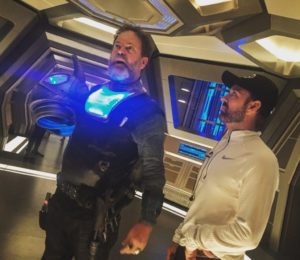
by Jim Hemphill in Columns via Film Maker Magazine
on Feb 14, 2018
A couple years ago, I was in a hotel room flipping channels when I came across an episode of the popular CBS series Blue Bloods, an ensemble family drama in the form of a procedural anchored by Tom Selleck. I was struck almost immediately by how stylistically expressive the episode was; it was clear that the director had thought through a precise means of conveying each character’s perspective in a distinctive way, assigning specific focal lengths, camera moves, and color and lighting strategies to each protagonist. It was the kind of subtle but dynamic approach to visual design one finds in the classical Hollywood cinema of directors like Michael Curtiz and Victor Fleming, and I was stunned to find it on TV while casually channel surfing. I made a note of the director, David Barrett, and began looking up his other credits.
I quickly discovered that the Blue Bloods episode was not an outlier; Barrett’s work on shows as diverse as Arrow, Under the Dome and The Mentalist were equally impressive, and his contributions to Blue Bloods — on which he is an executive producer as well as the primary director — have expanded and deepened that show’s visual grammar in a way that is as rare and valuable as it is easily taken for granted. Last year, while on hiatus from Blue Bloods, Barrett directed one of the best hours of sci-fi television I’ve ever seen, the “Magic to Make the Sanest Man Go Mad” episode of Star Trek: Discovery. It’s a time loop narrative — a kind of Groundhog Day in space — that encompasses major character developments important to the arc of the series as a whole, but races through them in a breathlessly intricate plot expertly constructed by writers Aron Eli Coleite and Jesse Alexander. In Barrett’s hands, the pace is swift without ever feeling rushed or chaotic, and the emotionally resonant moments are expertly balanced with the comic and suspenseful ones; his direction of the actors is as sensitive as his action filmmaking is kinetic. I spoke with Barrett by phone while he was taking a break from shooting a new Blue Bloods episode, and asked him about breaking down a script, working with actors, and the pressures of taking on a beloved franchise — especially when that franchise is being used to launch an entirely new streaming service (CBS All Access).
Filmmaker: It seems to me that one of the challenges with your episode of Star Trek: Discovery would be keeping the audience acclimated throughout the various time jumps… if the director doesn’t have his hands firmly on the controls, the material can come across as chaotic and confusing rather than involving and surprising. What was your initial response to the script?
David Barrett: Well, my first thought was that it was overwhelming, because it was a new show and a lot was riding on it for CBS. On top of that I’ve got a time jump episode, which means you have to choreograph every extra, every prop, every light, every actor’s gesture multiple times. You have to figure out how to make each scene different than the version before, but still the same — when a character comes in with a new piece of information that’s different from the previous time we saw that scene, what’s the ripple effect? You have to follow that ripple effect down to every background artist. So if you have 100 extras, that’s 100 people that you have to think about — what are they doing differently? In the first draft of the script I think there were eight different time loops, so that’s literally 800 beats that I had to choreograph and justify for the background artists, crew, and cast. If you go to a new time loop and you’re not specific about what’s different and why, everybody starts to check out, especially when it’s hour twelve in the day. Whenever a question is asked of you in one of these complicated episodes, if you’re not able to answer it clearly and decisively you’re going to lose everyone. They’ve all got muscle memory from doing the scene one way, and it’s very difficult to break that muscle memory.
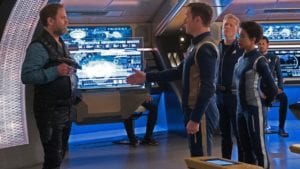
Filmmaker: And you have to make it make sense not just for the cast and crew but for the audience, which means finding multiple ways of directing the same scene that are different yet organic. Every time you go back to the beginning of the time loop, I noticed that you were altering the way you moved the camera to convey that while the story might be repeating, the emotional and psychological underpinnings of the scene were shifting.
Barrett: Right, in addition to making sure the time loop makes sense for the audience, I also had to keep them from becoming bored by the repetition, which they would if I shot it the same way each time. So I had to figure out how the different emotions in each time loop would determine what I was going to do with the camera — I approached each segment differently depending on whose point of view we were seeing the time loop through and what new information that character now had. We started out in studio mode, then went to Steadicam, then to Steadicam with a remote zoom, then handheld, then handheld with a remote zoom — I wanted to get across the increasing sense of desperation. From a production standpoint, I’m sure the thinking was that the episode would be easier than normal because we could just steal pieces from the original time loop rather than shoot fresh material every time, but in order not to be redundant I had to shoot original footage each time so that the audience didn’t feel cheated.
Filmmaker: Well, if a character has new information, then you have a responsibility to cover it differently.
Barrett: Exactly. If the behavior is different you have to complement that with the camera.
Filmmaker: What’s your process for planning all that out? As you said, there are hundreds — thousands, really — of moving parts you have to keep straight in your head before you ever get to the set. For each character there are dozens of decisions having to do with blocking, camera movement, lens choice, how you choose to light and frame the scene, color, etc… and it’s exponentially increased by the time loop conceit. How do you keep it all straight in your head?
Barrett: It was the most complicated script I’ve ever shot in my life. What I had to do was sit on the floor in my hotel, and every time I got a new revision — and that was another challenge, the script kept changing — I had to cut the script up into pieces and lay it out on the ground. I had so many different columns on my floor trying to keep track of the different time loops and what all the characters were doing that I had to move into a bigger hotel room. [laughs]
Filmmaker: You mentioned the additional pressure of this being a new show, and a show that’s essentially launching a streaming service — I know they had The Good Fight, but this was the show CBS was really using to try to drive subscriptions to All Access. What was it like coming into that kind of environment as a hired hand, as opposed to working on Blue Bloods, which is an established hit where you’re the boss?
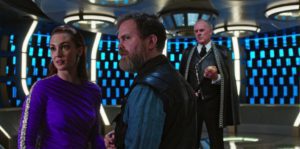
Barrett: Well, I’m never the boss — the showrunner and the audience are the boss. In the case of Blue Bloods, it’s very difficult to be on a show that’s been on that long and keep motivating, pushing, and inspiring people — which you have to do, because the minute you start to coast, the numbers go down. To keep pushing the boundaries and remain passionate and inspire the crew on a show that’s been on for eight years isn’t easy.
Now, Star Trek: Discovery was scary as hell, to be honest. The responsibility was almost paralyzing. I was so grateful for the opportunity to come on board something as iconic as the Star Trek franchise, and I didn’t want to be the guy who underdelivered. The best way I can explain coming in as a guest director is to say… imagine starting a new job every 15 days. Because you usually have around seven days of prep and an eight-day shoot. So imagine going to a brand new job, meeting everybody, and running it — you’re expected to have all the answers, even though everybody else has been there for months or years and you’ve just arrived. The tricky thing is that you have writers and showrunners and a network to serve, and you want to deliver the tone that they want – but you have to deliver it in a way that they never imagined. In the case of Star Trek: Discovery, nothing had aired yet, so I approached this like I was shooting a pilot — ordinarily when I come on to direct a show, I watch every previous episode and try to honor the style they’ve set up, but in this case there wasn’t much footage available to watch. One of the first episodes of television that I ever directed was an episode of Enterprise [a Star Trek series starring Scott Bakula that ran from 2001-2005], so I’ve always loved Star Trek. I loved what J.J. Abrams did with Star Trek. I loved the way he complemented the actors’ energy with the camera. I wanted to do something similar here; my priority was really drawing the audience into Burnham’s experience, so that they would feel what it was like for her to experience love for the first time. In the scene where she’s falling in love at the party, every decision from the long lens to the lighting to the actors’ gestures — where his hand falls on her back, when her hand touches his shoulder — is designed to make it feel as though those are the only two people in the room. I wanted to put as much detail into her behavior as possible so that the audience would really relate to her and feel those moments when he took her breath away. In terms of directing the actors, it was about giving them permission to fall in love with each other — I told them to let everything else around them fall away, to never break eye contact, to listen to each other intently. The actors had to be fearless, which they were.
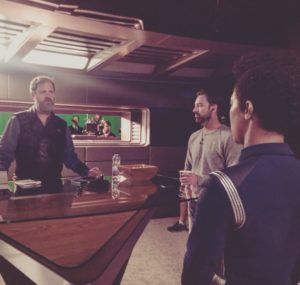
Filmmaker: There’s a wonderful intimacy to that scene, yet there’s also a great sense of scope. The romantic moment takes place against the backdrop of this huge action story, and the series as a whole does a great job of balancing the intimate and the epic — it’s something I’ve noticed about the series as a whole, not just your episode. The show has the scale and ambition of a great sci-fi feature film, without the kind of straining against the resources that you sometimes find in television. I’ve noticed that some of the other shows from Secret Hideout [Alex Kurtzman’s company, which produces the series] have similarly high production values…what’s it like for you as a director to have that kind of canvas?
Barrett: Well, here’s a quick example from that scene we were just talking about: I’m sure they spent a lot of money to get the Al Green song, which I never would have imagined I’d be able to get. But the producers selected it and paid for it, and it added a whole other layer to the scene, which speaks to how important it is to have good producers with high standards and expectations. I can deliver pieces of a good scene, but without smart producers who know how to take full advantage of those pieces in post and a good editor who understands sound, cinematography, and emotion — and the editor on this show, Andrew Coutts was one of the best I’ve ever worked with — a scene like that can fall totally flat. The great thing about Star Trek is that everybody is all in, from the first A.D. to the producing director to the showrunners to the writers to the line producer. I remember a point on the second day of shooting where I was playing it a little safe and [executive producer] Heather Kadin called me. She said the dailies were looking good and they were happy, and I said, “I’m glad you’re happy, but I feel like I’m playing it too safe.” She said, “We hired you to shoot the show the way you see it. Don’t play it safe. Shoot it.” That was a pivotal moment that had a lot to do with why the episode turned out as well as it did. And everyone was like that. There was another director, Doug Aarniokoski, who did the episode before me and shared what was working and what wasn’t — he was very gracious about giving me the lay of the land. The A.D., Woody Sidarous, gave me his weekends; [showrunner] Aaron Harberts stayed on the stage after wrap one night and spent hours working on the script, then went right to the airport to get on a flight back to L.A. — he never even slept. Then another writer, Ted Sullivan, flew in with three hours notice and spent the whole shoot with me making the script perfect. Then there was the cinematographer, Glen Keenan, and the producing director Olatunde Osunsanmi…. I’m not trying to be political here, this is the truth — these people were all instrumental, and all very generous with their time and knowledge. It truly was a collective effort. And I ask them all a lot of questions, because every moment on every page of the script means something to me. I need to know the meaning behind every line so that I can be as specific as possible with the actor — the more I can give them, the more confidence they’ll have and the safer they’ll feel committing to their own interpretation of the scene.
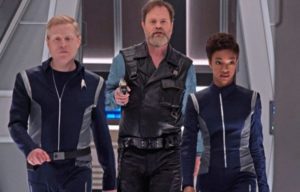
Filmmaker: Well, that leads me to what I respond to so strongly in your work, which is that you’re clearly an actors’ director but you’re also very visually oriented, and you pay full attention to both performance and visual style without compromising either. How do you keep that balance? What motivates the decisions that go into blocking the actors and composing the frame?
Barrett: It’s all about character. Whose point of view is it in the scene? I’ll shot list and block from whatever point of view the story is being told. Knowing that point of view and the emotion that’s being expressed informs everything, from the blocking and behavior to the color palette of the production. I’m working off of whatever I felt the first time I read the script — everything is driven by that initial emotional response. Every department — camera, wardrobe, production design — has an opportunity to help tell the story, and it’s the director’s job to inspire each department to put an extra bit of care and purpose into their work. Collectively, that’s the difference between an episode that moves an audience and an average episode.
Filmmaker: I know you have a long relationship with CBS… was directing something for their streaming service a different experience?
Barrett: Well, I was very aware of what it meant to the network, so I was thinking about it from both a creative standpoint and a business standpoint. I had been reading about what Les Moonves was saying to Wall Street — he wanted to produce something for the audience that was really, really special. CBS was putting everything they could into this in an effort to launch the app, because it’s a whole new revenue stream for them. So in that sense I was conscious of it being a show for the app, but no matter what platform you’re directing for you never want to take shortcuts or cheat the audience. Never. Star Trek is one of the biggest franchises in the world, and I was determined not to leverage the name or just rest on the laurels of the franchise but really give the audience a fully dimensional experience. You’re only as good as your last job in this business, so you have to put everything you’ve got into every one — that’s the way I approach it.
Jim Hemphill is the writer and director of the award-winning film The Trouble with the Truth, which is currently available on DVD, iTunes, and Amazon Prime. His website is www.jimhemphillfilms.com.

[/2_3_last]


